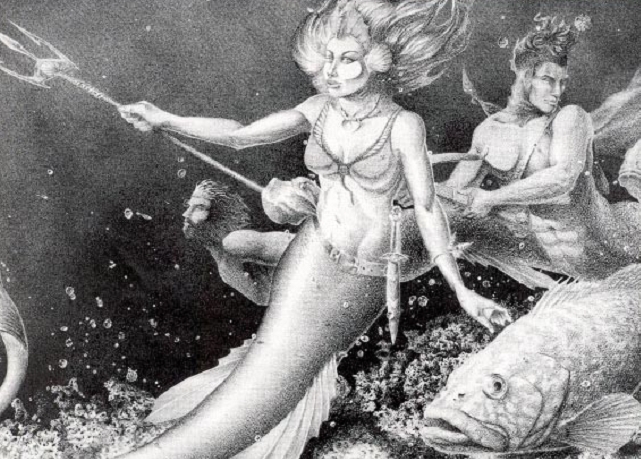
| Priests beneath the waves | Sea-priest spells | Using sea-priest spells | Altered spells | New priest spells |
| Dragon | - | Classes | - | Dragon 165 |
| 1st | 2nd | 3rd | 4th | 5th | 6th | 7th | Up |
| 1st level | 2nd level | 3rd level | 4th level | 5th level | 6th level | 7th level |
| Bless | Aid | Animate dead | Abjure | Air walk | Animate object | Animate rock |
| Combine | Augury | Continual light | Cloak of bravery | Anti-plant shell | Anti-fish shell* | Astral spell |
| Command | Chant | Create food* | Control temperature, 10' radius | Atonement | Blade barrier | Confusion |
| Cure light wounds | Charm person or mammal | Cure blindness/deafness | Cure serious wounds | Commune | Conjure fish* | Conjure earth elemental |
| Detect evil | Detect charm | Cure disease | Detect lie | Commune with nature | Conjure water elemental* | Control weather |
| Detect magic | Enthrall | Dispel magic | Divination | Control winds | Feast* | Earthquake |
| Detect nets* | Float** | Feign death | Fish summoning I* | Crustacean plague* | Find the path | Exaction |
| Detect poison | Find traps | Frond* | Giant crustacean | Cure critical wounds | Forbiddance | Gate |
| Endure heat/cold | Heat metal | Glyph of warding | Hallucinatory forest | Dispel evil | Heal | Holy word |
| Entangle | Hold person | Hold undersea animal | Hold plant | Fish growth* | Part water | Regenerate |
| Faerie fire | Know alignment | Inkjet** | Imbue with spell ability | Fish summoning II* | Speak with monsters | Reincarnate* |
| Invisibilty to fish | Manta ray watch* | Locate object | Lower water | Moonbeam | Stone tell | Restoration |
| Invisibilty to undead | Messenger | Magical vestment | Neutralize poison | Plane shift | Transport via plants | Resurrection |
| Light | Obscurement | Meld into stone | Plant door | Quest | Turn wood | Swarming doom* |
| Locate fish or plants* | Resist fire/cold | Negative plane protection | Protection from evil, 10' radius | Raise dead | Wall of coral* | Succor |
| Protection from evil | Shellskin* | Snare | Repel crustaceans* | Spike stones | Weather summoning | Sunray |
| Purify food* | Silence, 15' radius | Plant growth | Speak with plants | Transmute rock to mud | Whirlpool** | Symbol |
| Remove fear | Siren song* * | Prayer | Spell immunity | True seeing | Word of recall | Transmute metal to wood |
| - | Slow poison | Remove curse | Starshine | - | - | Wind walk |
| - | Snake charm | Remove paralysis | Sticks to snakes | - | - | - |
| - | Speak with fish* | Speak with dead* | Tongues | - | - | - |
| - | Spiritual trident* | Spike growth | - | - | - | - |
| - | Warp wood | Stone shape | - | - | - | - |
| - | Water devil* | Summon crustaceans* | - | - | - | - |
| - | Wave** | Water breathing | - | - | - | - |
| - | Withdraw | Water walk | - | - | - | - |
| 1d100 | Incarnation |
| 01-03 | Dolphin |
| 04-08 | Merman |
| 09-12 | Urchin (yellow) |
| 13-16 | Locathah |
| 17-19 | Sting ray |
| 20-23 | Urchin (black) |
| 24-28 | Vurgens |
| 29-31 | Triton |
| 32-34 | Pungi ray |
| 35-36 | Swordfish |
| 37-40 | Moray eel |
| 41-44 | Urchin (green) |
| 45-58 | Same race as spell-caster |
| 59-61 | Manta ray |
| 62-64 | Jellyfish |
| 65-68 | Urchin (red) |
| 69-70 | Ixitxachitl |
| 76-80 | Shark |
| 81-85 | Sahuagin |
| 86-00 | DM's choice |